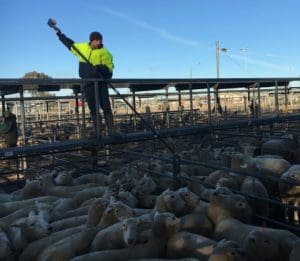
Sheep with EID tags being scanned at the Ballarat saleyards.
BALLARAT has emerged as the first Victorian saleyard to consistently scan and upload data from electronically identified sheep and lambs at commercial sales in the lead-up to the 2018 statewide saleyards EID scanning deadline.
Saleyards across Victoria are currently trialling tag scanning equipment and software prior to the October 31 2017 deadline for infrastructure funding and installation.
But with a new Central Victorian Livestock Exchange due to be built at Miners Rest in Ballarat within the next 12 months, operations manager Jonathan Crilly and his staff have been trialling the wand scanning of any EID-tagged sheep and lambs for the past two weeks and uploading tag data to the National Livestock Identification System database.
Mr Crilly said wand scanning of sheep and lambs at Ballarat over the past two weeks was an interim measure.
“I looked at the situation and we can’t justify a lot of the draft and race readers that people are looking at.
“They’re (the EID software and equipment suppliers) not even ready and even if they are ready in the next couple of months, we would still a less than 12 month window, the cost of that is just not justifiable.”
Click here to get the latest Sheep Central story links sent to your email inbox.
Despite having until March 31 2018 before all EID-tagged sheep and goats in saleyards must be scanned to an action level of 80 percent, Mr Crilly said he had looked at various EID scanning options.
“In December, in the peak of our season, we will still be in the old yards and last year we peaked at 68,000 head in a single sale.”

CVLX operations manager at Ballarat Jonathan Crilly.
Mr Crilly said he considered applying for an exemption for EID scanning, but opted not give any other saleyard an advantage by losing market share. Ballarat’s agents are currently yarding around 6000 sheep and lambs at the weekly sale, but not all of these have to be scanned.
“We’re getting virtually no new seasons lambs that have been born in 2017 with the white EID tags, what we’re getting is older lambs that have been brought in primarily from being re-fattened and a few older sheep from potentially stud breeders who have been using electronic tags.
“One of the problems we’ve encountered is you might get a pen of say 40 lambs that have been brought in from five different properties, refattened, and no-one knows or can be expected to know, exactly how many EID tags there are in that pen.”
Mr Crilly said pens with EID-tagged sheep are being successfully identified by suspending the wand over pens as the operator walks around.
“It’s remarkably effective – I can get 100pc.”
He is now seeking feedback from abattoirs to see how their scanning compares to the saleyard results.
Mr Crilly did not believe wand scanning of sheep and lambs was viable for the Ballarat saleyards long-term.
“But I think it is certainly an option for small yards.
“It’s a known method of working with cattle; it’s not dissimilar,” he said.
“The first week we scanned 360-370 and last week had only 115 or something.
“It’s a starting point and the number I’m scanning is not the point.”
Two people can check the yarding for EID-tagged sheep and lambs in about an hour, starting about half an hour before the sale.
For the new saleyards, Mr Crilley said he was leaning toward a single scan system at the drafting stage, with a component of small lot scanning with wands.
AAM Investment group managing director, Garry Edwards said it is imperative that the company develop and implement a system at CVLX — Victoria’s largest sheep selling facility — that can reliably and cost effectively deliver compliance and market enhancement programs for the benefit of producers and livestock agents.
“More importantly, though there are a whole host of benefits underpinned by sheep EID systems that will continue to be implemented into the future at the new CVLX livestock selling facility that is currently under construction”.
Mr Edwards indicated he was confident that CVLX will meet all key industry milestones for technology implementation to fully adopt sheep EID traceability in 2018 and welcomed Agriculture Victoria’s support in refining and developing systems that will benefit the industry as a whole.

HAVE YOUR SAY